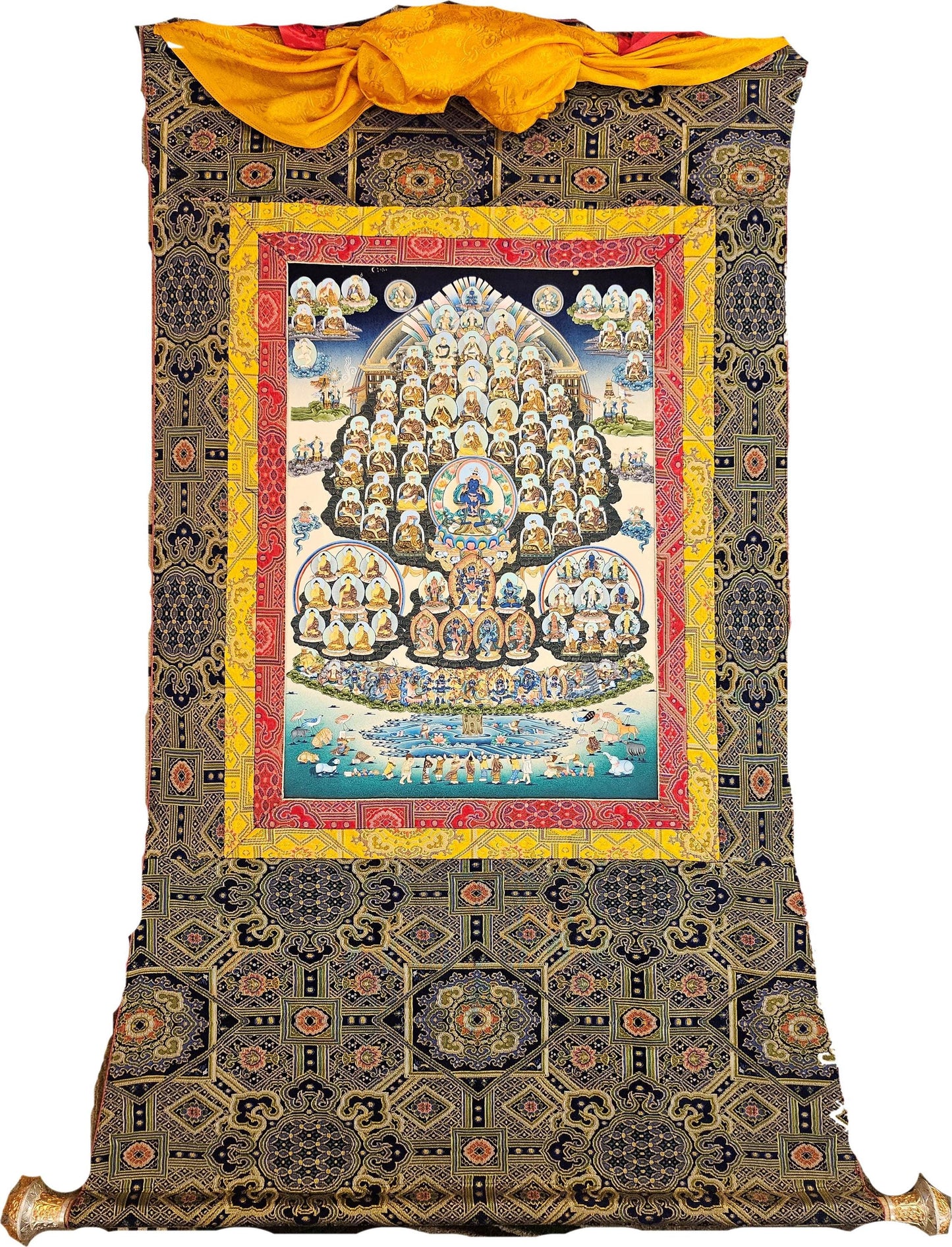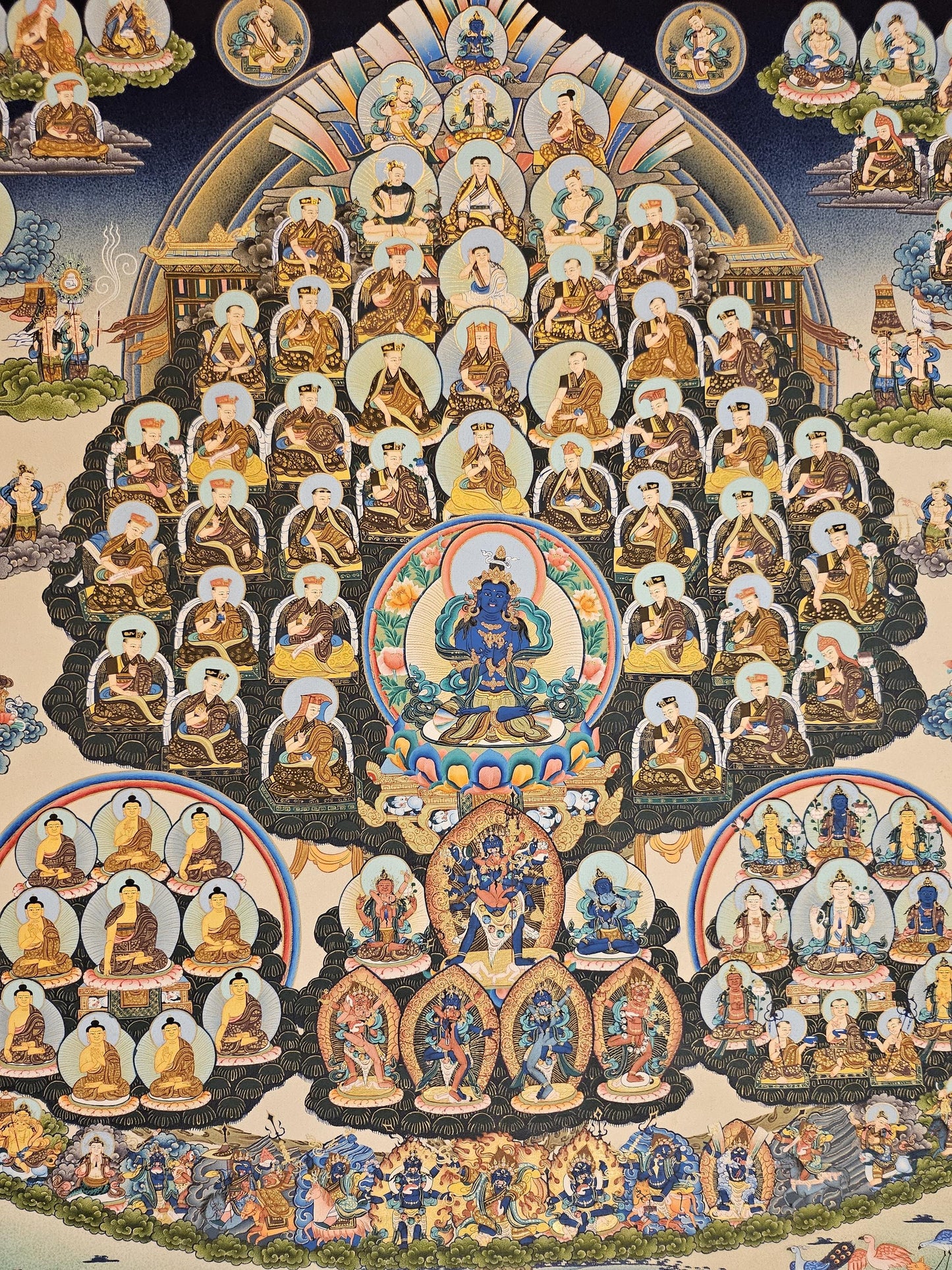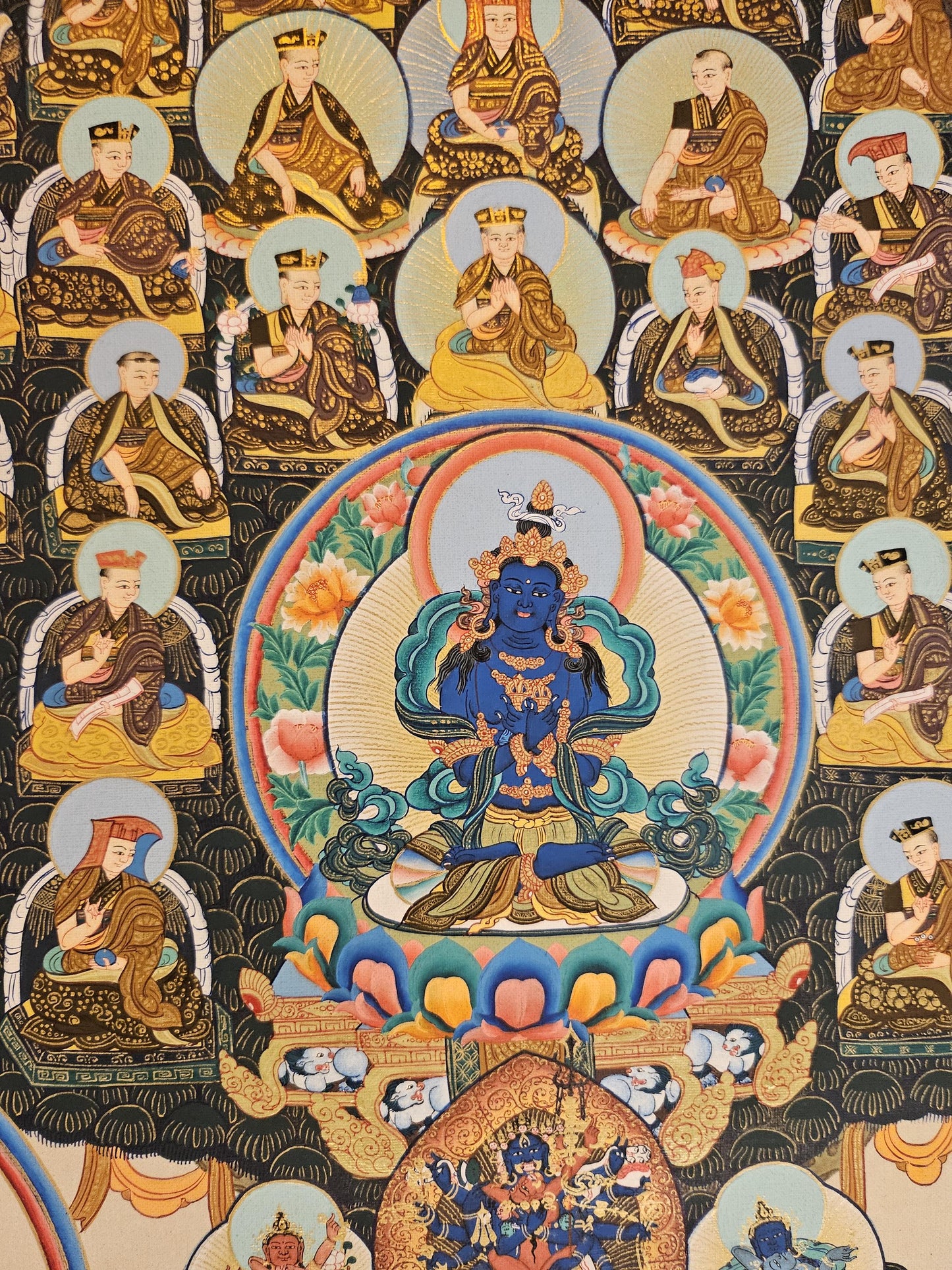1
/
of
4
My Store
230. Karma Kagyu Lineage Tree Thangka (Thanka) Painting with 24 K Gold and Hand Loomed Khadi Brocade. Free Shipping.
230. Karma Kagyu Lineage Tree Thangka (Thanka) Painting with 24 K Gold and Hand Loomed Khadi Brocade. Free Shipping.
Regular price
$1,200.00 USD
Regular price
Sale price
$1,200.00 USD
Quantity
Couldn't load pickup availability
Karma Kagyu Lineage Tree with Hand Loomed Khadi Brocade
Karma Kagyu is a widely practiced and probably the second-largest lineage within the Kagyu school, one of the four major schools of Tibetan Buddhism. The lineage has long-standing monasteries in Tibet, China, Russia, Mongolia, India, Nepal and Bhutan, with current centres in over 60 countries. The spiritual head of the Karma Kagyu is the Gyalwa Karmapa; the 2nd through 10th Karmapas were principal spiritual advisors to successive emperors of China. The Karma Kagyu are sometimes called the "Black Hat" lamas, in reference to the Black Crown worn by the Karmapa.
The Kagyu lineage claims a continuity of oral instructions transmitted from master to disciple. This emphasis is reflected in the literal meaning of Kagyu. The first syllable, ka, is said to refer to the texts of Buddha's teachings and to the master's verbal instructions. Ka has the double meaning of the enlightened meaning imparted by a teacher's words, as well as the strength that such words of insight may bear. The second syllable, gyu, means lineage or tradition. The combination of these syllables thus means “the line of orally transmitted instructions.” The elders in the Kagyu lineage, representing the theoretically uninterrupted line of masters and disciples reaching back to Buddha (Vajradhara), are jointly known as the “Golden Rosary.”
The Karma Kagyu was founded by Düsum Khyenpa, 1st Karmapa Lama. It is headed by the Karmapa; followers believe that the Karmapa's appearance as the first historical consciously reincarnate lama (tulku) was predicted by Gautama Buddha in the Samadhiraja Sutra.
The Karma Kagyu school belongs to the Vajrayana branch of Mahayana Buddhism. It conceives itself as a member of the third turning of the dharmacakra and participates in the Rimé movement. Important teachings of the Kagyu school include the Buddhist philosophical traditions of Yogacara and Madhyamaka, as well as the tantric tradition of Chakrasamvara, among others.
The view known as Shentong (empty of other) has become popular in Karma Kagyu, due to its promotion by the influential Rimé philosopher Jamgön Kongtrül Lodrö Thayé (1813–1899). This Shentong view has been upheld by various modern Kagyu masters such as Kalu Rinpoche and Khenpo Tsultrim Gyamtso Rinpoche. However, as noted by Karl Brunnholzl, several important Kagyu figures have disagreed with the view of "Shentong Madhyamaka", such as Mikyö Dorje the 8th Karmapa Lama (1507–1554) and Pawo Tsuglag Threngwa, the second Pawo Rinpoche, both of whom see "Shentong" as another name for Yogacara and as a separate system to Madhyamaka. Both of these figures, as well as the Ninth Karmapa, Wangchuk Dorje, criticized the Shentong view and held that the teachings on Buddha nature were of expedient meaning.
The central yogic practice of the Karma Kagyu is the doctrine of Mahamudra, also known as the "Great Seal". This doctrine focuses on four principal stages of meditative practice (the Four Yogas of Mahamudra):
The development of single-pointedness of mind, The transcendence of all conceptual elaboration, The cultivation of the perspective that all phenomena are of a "single taste", and The fruition of the path, which is beyond any contrived acts of meditation.
It is through these four stages of development that the practitioner is said to attain the perfect realization of mahamudra. Mahamudra is practiced both independently and as the completion stage of Vajrayana practice.
Within the Karma Kagyu, meditative practice is almost invariably presented in a progressive manner. Early practice includes samatha, introduction to Buddhist history and philosophy and initiation into the lower tantras - classically across the iṣṭadevatās (Wylie: yi dam) Avalokiteśvara, Tārā and Amitābha. This is followed by ngöndro and vipassanā. During the traditional three-year retreat, retreatants usually focus their practice on the Six Yogas of Naropa. At the Anuttarayoga Tantra level of practice, the principal iṣṭadevatās of the lineage are Dorje Pakmo, Hevajra and Cakrasaṃvara.
The supreme lama of the Karma Kagyu is the Karmapa, who always presides as lineage holder once he has reached his majority and received all the necessary training and dharma transmissions. From the death of one Karmapa until the next takes his seat as lineage holder, one (or more) of the previous Karmapa's principal disciples holds the lineage. Rangjung Rigpe Dorje, 16th Karmapa left the lineage in the hands of four eminent lamas: the 14th Shamarpa, the 12th Tai Situpa, the 3rd Jamgon Kongtrul and the 12th Goshir Gyaltsab. There is controversy over who is the 17th Karmapa, with two major candidates both having been recognized and enthroned by their supporters. Neither candidate has been enthroned at Rumtek Monastery.
Size without brocade:
Size: 17 inches by 24 inches
Shipping:
We ship within 2 business day.
DHL Shipping: 5 to 8 business days with tracking number.
Insurance against loss.
We do wholesale too.
Our one and only priority in this business is to provide "Hassle free Customer Satisfaction". We have "Quality Products" with "Cheapest Price" in the market.
Please contact us to resolve any issues. Contact us via email before leaving any negative or neutral comments. We promise you that we will resolve any issues.
Please confirm the return address with us before returning the product.
Share







